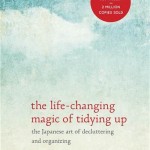“Whether you’ve read her book or not, you might be wondering how Marie Kondo’s methods of decluttering and organizing stack up with my own, which also come from a lifetime of experience and years spent in the business of helping people clear their homes of unwanted stress and stuff.”–Stephanie Bennett Vogt
If sales figures are any indication, it seems that the world is fed up, maxed out, and ready to listen. In my twenty years as a space clearing professional, I’ve never seen a book take the world by storm like The Life-Changing Magic of Tidying Up.
We live in an insatiable culture of “more” and “better.” We are swimming in stress. Closets (and landfills) across the land are stuffed to the gills with things nobody needs or uses. And even if the desire to simplify is genuine, most are lost as to where to start (or even begin) to reduce the excess and quiet the noise.
Yes, it’s a jungle out there. The situation is as dire as I’ve ever seen.
The author of this unassuming little book with the soothing turquoise cover is Marie Kondo, a beautiful, demure Japanese master declutterer who cuts through the piles with the tough-love methods of a Ninja warrior. “Tidy in one shot,” she advises. “Discard first, put away later.”
I love her tips on how to fold and stack clothing (upright). I love that she busts us (me) on the spot for hanging on to paper that we will never use or read again. I love her invitation that we hold each one of our possessions in our hands and ask: “Does this spark joy?”
Her approach to clearing books by placing them all on the floor and “exposing them to fresh air and making them ‘conscious'” makes sense. Besides me, she’s the only other person I know who suggests we honor our things on their way out the door.
She’s good. Very good.
Whether you’ve read her book or not, you might be wondering how Kondo’s methods of decluttering and organizing stack up with my own, which also come from a lifetime of experience and years spent in the business of helping people clear their homes of unwanted stress and stuff.
The truth is, we both love nothing more than to deliver life-changing magic for our students and readers. We both were organizational geeks as children – always looking for the best ways to bring order to chaotic spaces. We both believe that the home is not just some empty box that we fill with our things, but a living, breathing animate presence that supports and informs us.
And yet with all those similarities, our approaches to clutter and clearing, could not be more different.
So what gives?
Consider these distinctions:
Kondo offers fantastic tips – some of which I adore and have implemented myself in my home. You can read about them in these three previous posts: Taming Clothes, Taming Paper Clutter, and Does it Spark Joy?
That said, I believe that with a slight vector shift of attention we can play an even bigger game that can lead to even more magical outcomes.
As I see it, it is not about the stress and stuff, nor about “getting rid of” the stress and stuff. It is ultimately how we relate to them – how we relate to the emotional patterns that led to that stress and stuff.
It doesn’t matter if your challenge is the mildewing boxes in the attic, the dog next door that barks all night, or the annoying hairball on your jacket. When you bring your compassionate awareness to the feelings that these things activate in you – i.e. the attachment, the shoulds, the guilt, the fears, the shame – you lighten the energetic load you carry. Lightening the energetic load reduces the physical one – like magic.
Being the compassionate observer of your experience is the work. The stress and stuff gives you a fantastic opportunity to practice.
My “slow-drip” approach to clearing wasn’t just some crazy idea I dreamt up. It is grounded in science and based on another Japanese principle, in fact, called Kaizen – the practice of continuous improvement. It was another little hardcover book by Robert Maurer, Ph.D. called One Small Step Can Change Your Life: The Kaizen Way, that was the real game changer for me in my work.
It turns out that Maurer’s baby-step methods, designed to bypass the brain’s fight-or-flight wiring, work like a charm to reduce overwhelm, clutter, and anything that keeps us stuck.
The practice of slowing down and simplifying not only feels good, it creates new neural pathways in the brain that lead to new habits and lasting change.
When we focus on outcome and perfection we miss the opportunity to embrace our innate imperfections; to heal; and to enjoy the simple pleasures that come with cultivating ease.
As a recovering control freak who has exhausted herself reaching for perfection and trying (way) too hard to bring about change, let me save you years of efforting and unnecessary suffering.
Getting your closets and drawers, papers and problems “under control” is not where it’s at. You can certainly try it and see where it takes you. My experience is that it’s hard, it’s exhausting, and does not ultimately lead to happiness.
The best advice I can offer to all of you out there desperate for change is this: Have fun with your tidying and clearing. Lighten up (as it were)! Aim for consistency every day, even if all you can handle is one minute.
Aim for progress, not perfection.
Clearing is not a race. You do not need to get it perfect. And you do not need to “get it done.”
All you need is to “get it.”
Destination, or journey?
What happens when we see decluttering and organizing as the endgame is that we miss some of the goodies that are buried below the stress and stuff. These goodies have the potential to take us to a whole new level of personal transformation.
My method may rattle a few cages from time to time, but it’s simple. It is a daily practice that integrates five key principles (the “Five S’s”): slow down, simplify, sense, surrender, self-care. It transforms clearing from a linear task that you do until it is done, into a revealing and nourishing journey of self-discovery that lasts a lifetime.
All at once, or bit by bit?
Tidy in one shot, or in baby steps?
Coke or Pepsi?
I sent out a survey recently to my readers and students about programs and resources that might better serve them. One of them responded with this: “Just did Marie Kondo’s book and cleared out everything. So no longer in the market for your work.”
She’s right. “The Spacious Way” to decluttering and organizing is not for everyone – especially for those who want to see change fast. In the end it boils down to personal choice and resonance.
That said, I do believe there is a winning middle ground where the two methods dovetail and can blend together nicely.
Here are some ways to play:
Tidy in this order: clothes, books, paper, komono (miscellaneous) sentimental attachments. Instead of going “all in” (and potentially stressing yourself out), apply Kondo’s technique to smaller, more doable tasks that won’t create huge piles of chaos on your floor. Remember, when you’re overwhelmed it means you’re in the red zone. You need to dial it back.
Tidy by category: Kondo’s suggestion to address your clutter by category instead of by room is ideal. For balance, follow up each session by rewarding yourself with something that feels really good. Put your feet up, have cup of tea, walk your dog, smell the roses. It will rewire your relationship to clearing and tidying – from something onerous – to something that you can’t wait to do again because of how good it feels.
Does it spark joy? Asking yourself if something makes your heart sing is a terrific measure of what stays and what goes. If you’re overwhelmed it may be easier said than done, however. (Cluttered minds do not make good decisions.) Create a “Don’t Know” pile to come back to later. Over time your don’t know piles will get smaller and smaller. They are also a nice visual reminder of how much progress you’re making.
The Spacious Way invites you to integrate a few key principles like continuity, ease, compassionate awareness, and self-care into a daily practice. If you’re looking for the immediate rush of seeing big huge garbage bags lined up along the hallway and empty shelves and drawers – to “get it out,” “get it done,” “do it faster” – this approach may not be your cup of tea.
Baby-step sessions may not look like much on paper, but if you stick with them, they will morph into seamless clearing that will surprise you.
It might even take your breath away. Like magic.
The Spacious Way
If you’d like to learn more about my counter-intuitive approach to clearing what’s holding you back, I recommend you read my first book Your Spacious Self: Clear the Clutter and Discover Who You Are. It is the foundation for a whole new way to clear. My second book, A Year to Clear, takes you on a deeper clearing journey of peeling more layers. It is designed to integrate the slow-drip principles in a daily, nourishing way. Both books are perfect companions to Kondo’s book.
End of Series*
Back to Part 1: Taming the Clothes
Care to weigh in?
What are you experiences of the KonMari method? Tell us in the comment thread. We welcome your thoughts!
This is the fourth in a series of four articles that chronicles my experiences and impressions of Marie Kondo’s hugely popular book called The Life-Changing Magic of Tidying Up. To catch up and read the previous posts, click the active links here:
- Taming the Clothes
- Taming Paper Clutter
- Does it Spark Joy?
- All At Once or Bit by Bit?
Dear Readers: If you found this message helpful, please forward it to someone else (or share, like, tweet, pin… ) and let’s build the clearing energy together that will help to lighten all of our loads!
Learn more…











Haven’t read her book yet, but have been interested to see your take on it. While I have been far from perfect in practicing small steps every day, I have developed great faith that it is the only thing that will work for me. So much so that I now use it (including your meditations) with whatever behavior I’m trying to change.
As for the clearing, I have not found that it gets any easier. I’ve dealt with the easy stuff, and repeatedly get stopped cold by the harder things. Now, it seems, I only am able to clear in fits and starts. Putting things in boxes and coming back to it months later helps, but it’s really slow going.
I received her book in e form for a book review, and while I enjoyed it, your approach is the one that meshed with me. I realize you’re not plumbing for compliments, but it’s true. Marie was too radical for me, and you use a tender way of clearing. Much better in my state of mind. I think her immaturity was showing just a bit.
I like that you’ve really put some thought into motive and focus and the idea that it is not just about end results. Clearing is a life practice and the method matters.
I participated in your course on Daily OM and have pre-ordered your book. In early 2014, I went through a major purge in my home in about 4-5 weeks — even got a dumpster for the driveway — we were preparing for a remodel in the house. That process was overwhelming and really brought up a lot of issues in my face — fast. I am a person who likes to get the job done — but even I was overwhelmed at the task I made for myself. Your course put a lot of things in perspective for me. I have a partner who is a borderline hoarder. I can see that a combination of your daily dose method and many of the points in Kondo’s book such as and the consciousness that she gives objects would work for him. But I love the compassionate self-care aspects of your method.
I was grateful to read this blog – to step out and look at the advantages of each method. I am needing to let go of the perfect ideal in a home and allow for the imperfections. As I go through any unfinished business around my home and learn to maintain, I plan to go through your course again. So glad, it will now be in print!! Thank you for your work.
I’m a Konvert 🙂 I’ve tried every clutter clearing method/book/blog I could find (I only came across yours during my KonMari adventure), and nothing ever worked. I lived with chaos all my life (I’m 48). Marie Kondo’s book utterly changed my life. It’s the “going by category” that makes all the difference – once you collect and SEE just how much you have of a particular category, you are changed forever – you never EVER EVER want to accumulate that much again. It doesn’t have to be a huge sweep though … you can do categories as small as you like (start with socks 🙂 )
I came across your blog through a post about clearing the stale energy of clutter clearing using salt baths, and I found it INVALUABLE – thank you!!!
love and gratitude,
Julie
I’ve read your earlier book and Marie Kondo’s and while I was initially excited about her method, I found I got stuck. The category idea was great but other parts felt too radical. Sparking joy was not enough for me to make a decision.
It is going to sound ridiculous but what works for me right now is pulling out about 5 books at a time, putting them on a card table next to me and over the next 2 to 3 days, leafing through them. I try to remember why I bought them in the first place and what I wanted to learn from them. I might take a few notes or photocopy a chart (or better yet, scan it into Evernote). Most often I realize I am no longer that person and can let the book go. While this sounds incredibly slow (and sometimes feels that way), I’ve gone from stacks of books on bookcases and around them to almost fitting all my books into my existing book cases (with some other items on them…). This same method also seems to work with my “someday / maybe” papers.
Hi Roxanne,
I totally LOVE your solution to handling books. As you probably already gathered by now, I’m a big fan of the “slow clear” approach. 😉
Thank you so much for sharing your method with us here, which is fabulous.
Happy clearing!
Stephanie
I loved this series, Stephanie. Even though I haven’t read the tidy up book, I have a few friends who have shared a couple of the tips you shared here. I can see the value in both approaches, at different times … we did a big clearing out as we moved 2 years ago & I was more in the Marie Kondo mode then (even w/o knowing it).
AND>>>of course it’s an ongoing process, so we need both. Your approach is very nicely aligned with my own natural, intuitive process. I always start feeling anxious when there is too much ‘stuff’ starting to overflow the drawers, cupboards, closets in my home. One thing I initiated when we moved is that I only have a set # of hangers in my closet, and when I buy something new (even at the thrift store) I make it a habit to remove something old. It keeps things fresh & manageable. Same with paper. Every year there is a clearing of the files before the next year’s records can go in.
Love finding your site & programs … and looking forward to sharing the ‘A Year to Clear’ book as a year long conscious clearing adventure. Thanks! S
Thank you so much for your comment, Sora! Love the “one thing in, one thing” out habit too. Let me know how it’s going for you with the book A Year to Clear! You may find it habit forming, too. 😉
Happy clearing!
Stephanie
I just found your site after doing the Kon Mari method. Loved her method because it got rid of the stuff I did not need. However, I am looking back at the categories and find that I need to go through it again.
Now that I can ‘see’ my favorite stuff I am finding that they are either torn, stained, falling apart. Not so favorites anymore. Without the Kon Mari Method I would have been lost.
Now is the time for your method. Yep, your method is just what I needed Post Kon Mari. I can be gentler with my possessions and really ‘look’ at them. Your method is the clean-up I needed. A slower, gentler more mindful method.
Thank-you
I just read the Kon Mari method and really loved it. As I was going through my clothes I had the feelings she described in her book which kept me going . It was a Wow factor for me that told me I was on the right track. After I finished and 4 huge garbage bags later. I felt such a release. However, a Year to Clear is slowing me down which I recognized that I needed to do after tidying my clothes. My plan is to used both methods and when I feel ready I will go back to the Kon Mari method reread the section on books and follow her directions to tackle my overflowing stacks of books. Shifting between both of these methods feels right for me. Things of value I am giving as gifts. I am a hospice chaplain and I see what a burden leaving behind “stuff” can cause. I am determined to leave a tidy house.
Brenda, your last statement, “…what a burden leaving stuff behind can cause…” is what is driving me… Thanks for posting here.
Last year, I cleared bags and bags of outgrown kids’ clothes and other possessions, but te post-holiday clutter has grown right back. Though Marie Kondo promises you won’t relapse, I did.
The “all at once” method may work for some, but maybe not a working mom. Life is complicated. I look forward to clearing excess baggage little by little, from the inside out.
6 months ago I read Kon Mari’s book on clearing clutter. I was determined to have it change my life. I started with clothes as suggested and brought all my clothes to the family room (too much for my bedroom or living room) I spend a couple of weeks (giving 4-6 hours each day) deciding if an object brought me joy. I noted my thoughts and feelings about all my clothes and got rid of everything that didn’t spark joy. I gave away bags of clothing and everything that didn’t fit me (I did keep a box of a few objects that were the next size down that I really loved and without a commitment to loose weight, just kept that small box, in case) My closets looked great, my drawers looked great, the floor by the side of the bed was clear…. yeah! i was happy… kind of.
For starters, I hadn’t thought of outfits… so now I had articles of clothing that sparked joy, but nothing to wear with it… right color belt or shoes or pants…and, I gained a few pounds… not a lot, but enough that the clothes that sparked joy don’t fit. I started not going places because I didn’t have clothes to fit…. (please know that I am telling this story with all the comedy and irony that it deserves)
So I bought a few new pieces. Cute!! but I wasn’t sure where they would go, because I’d done the plan exactly with everything in it’s place. I had a medium sized closet, so I figured that was all the space I needed. She’d mentioned several times that you have all the space you need.
What is still working is that i don’t have additional racks of clothing in my bedroom or garage to walk around, and my shoes and scarves and purses are still in great shape and easy to find and use. I still remove everything from my purse at the end of the day and tell it to “take a load off and relax… your home and enjoy” and I love this.
What hasn’t worked well for me is maintaining clothes. I could tell lots of stories about my “plans” to keep my clothes honored and organized, but… many times there are piles of clothes on top of my dresser “can i wear these one more time before I launder them?’. “These are clean but it takes so long to put them away with her method… new folding etc. maybe I can put them away next week when I have more time”… piles beside my bed “I’m tired”, “I’ll put these in the hamper (I bought a new one to have closer to my bed, but it’s still 20 steps away) tomorrow”.
Please know that even though sometimes I’m frustrated and tired and confused, I am ultimately enjoying this journey of being so blessed that I have too much stuff and discovering who I am and what I really want and need for my purposes. Thanks for asking and letting me share. xoxo
Just signed up for the course today. It felt like a great gift to see your ad on facebook and sign up. Years ago I started the flylady program. I benefited from adopting a few of her routines–checking my planner every evening and morning, doing a load of laundry every day, etc.–but the de-cluttering felt too intense and I didn’t do it. Years later, I’ve made some progress but not anywhere near enough to make me happy. I read Kon Marie’s book last summer and thought it sounded wonderful, but now it’s February and I’m still waiting for the perfect free day to get started. It sounds like such a huge project. Your approach sounds right for me. I’m much more willing to meditate and do yoga than I am to clean my house. If I have guidance in developing a spiritual practice of taking care of my stuff, I believe I can do it. Thank you.
I’ve read Kondo’s book also, and I knew right away it wouldn’t work well for me to drag all of my clothes out and start sorting through them. I’m no longer a young woman, and I don’t do marathons anymore. I didn’t notice much advice for those of us who physically can’t to what she described.
Your writing style and philosophy are botg beautiful. I am excited about starting your course!
For me, both these methods work in unison better than alone. Your methods are helping me where I was getting stuck with KonMari. Really, it is hard to get rid of physical clutter if you have cluttered time and headspace, so thanks for helping me work on those!